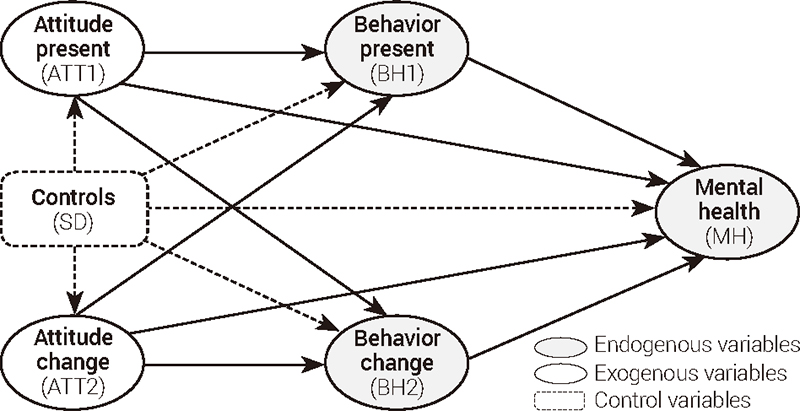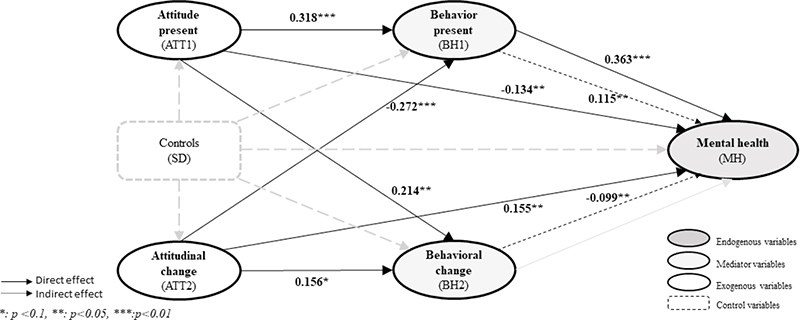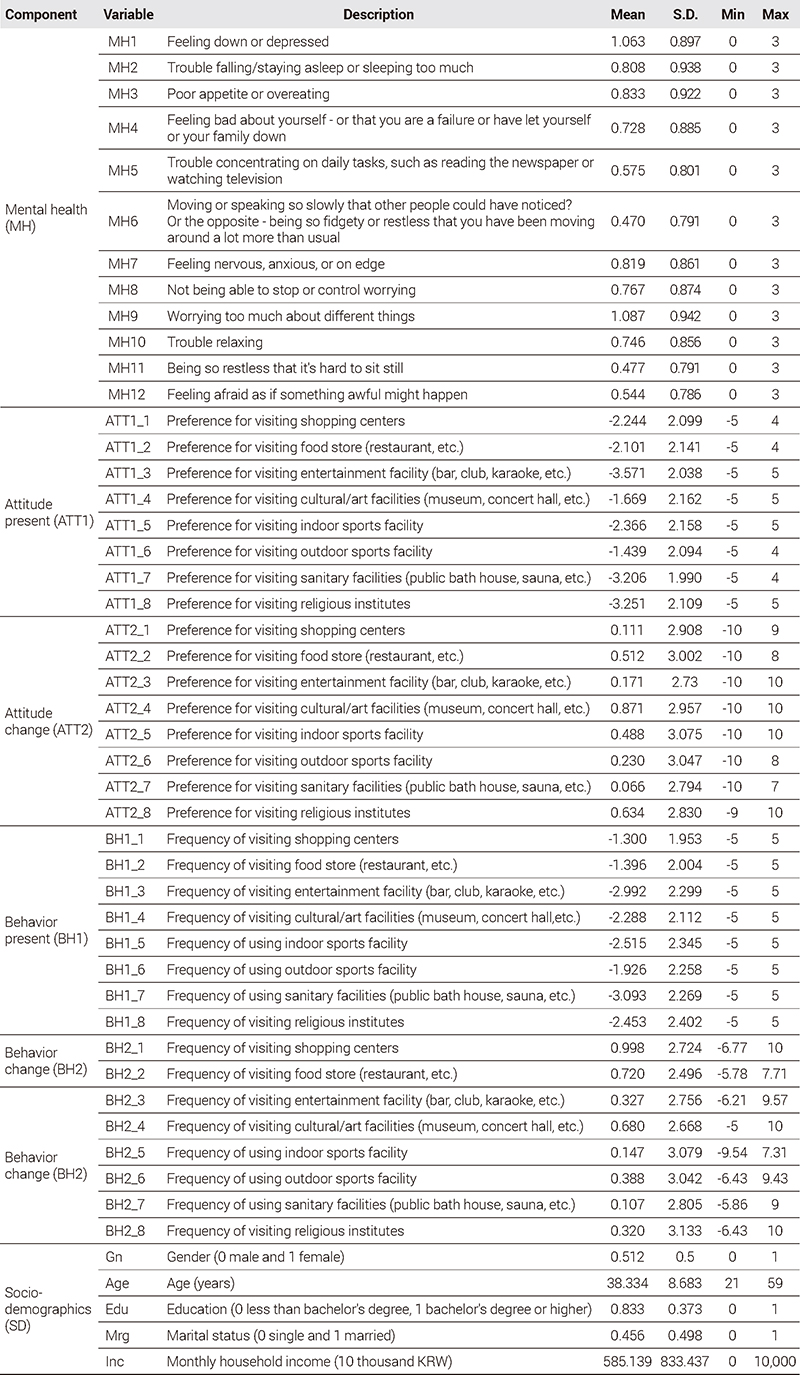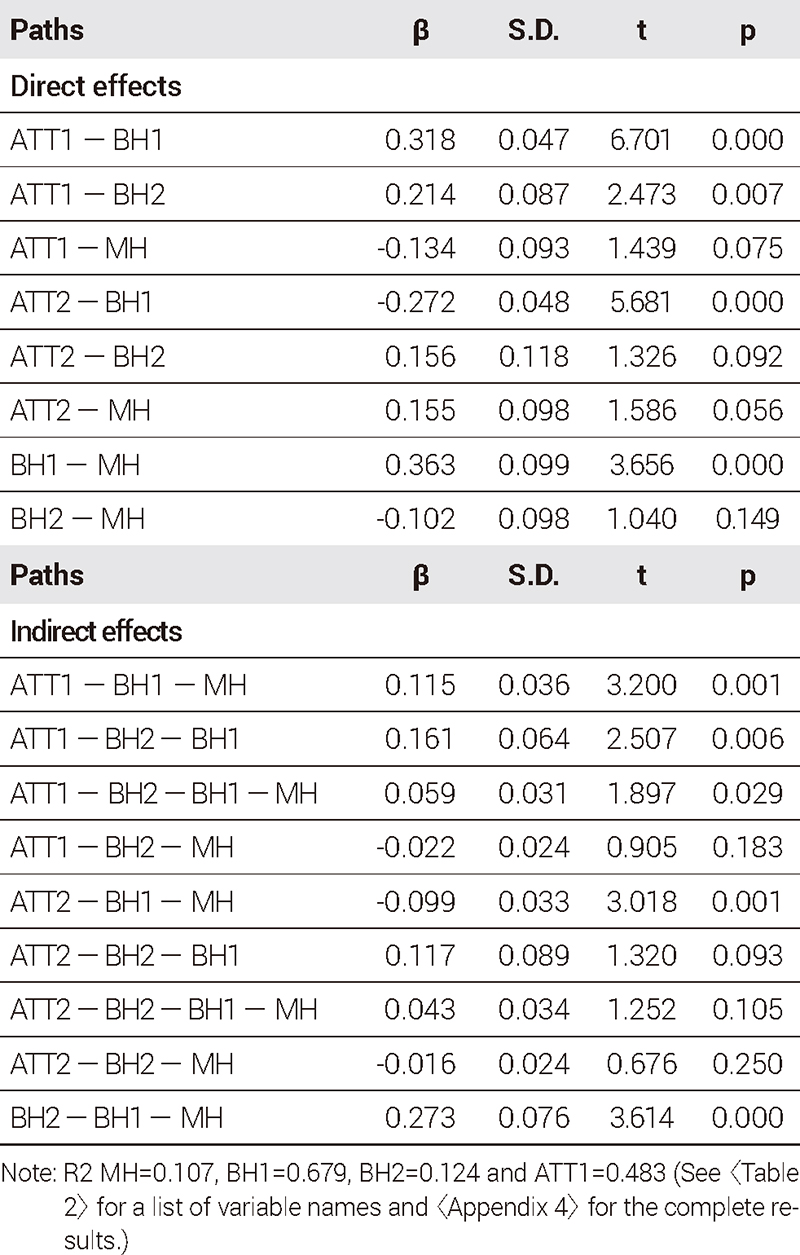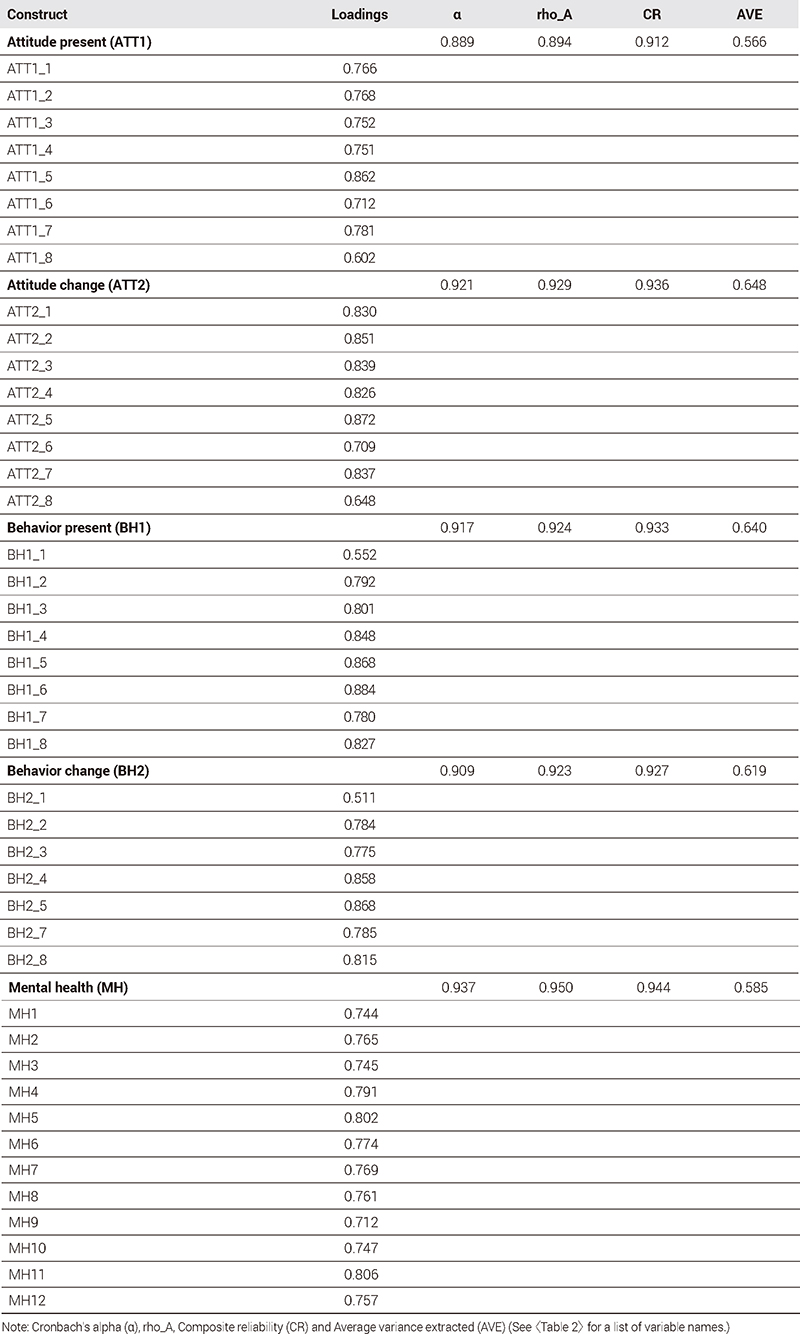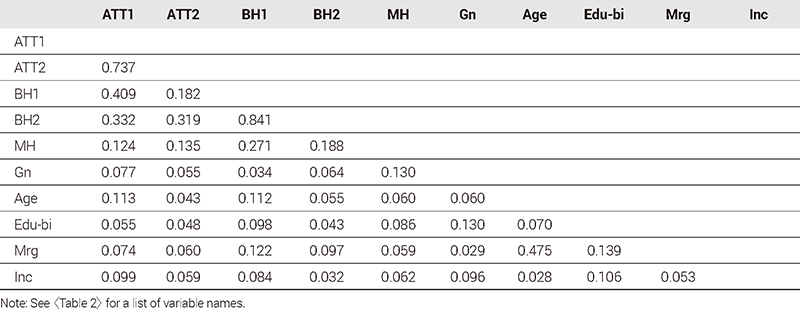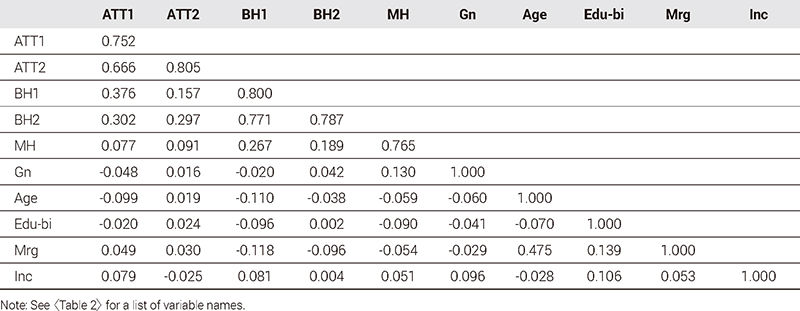
How Did Leisure Attitudes and Behavior Affect Mental Disorder during the Pandemic? Comparison of the Current Status and Temporal Change
초록
This study examines the changes in leisure attitudes and behaviors during the COVID-19 pandemic and their effect on mental health. It identifies the mediating role of leisure behavior in the relationship between leisure attitudes and mental health. The data were analyzed using PLS-SEM (Partial Least Squares Structural Equation Modeling) based on two online surveys conducted one year apart, involving 287 residents of the Seoul metropolitan area. The results indicate that both the current state and temporal changes in leisure attitudes and behaviors significantly influence mental health during the prolonged pandemic. While leisure attitudes have a direct positive effect on mental health, their indirect effect through leisure behavior is negative, as increased leisure behavior may adversely affect mental health. The findings suggest that the changes in leisure attitudes and behaviors are crucial factors in either promoting or undermining mental health during a pandemic. This study emphasizes the importance of considering the changes in leisure attitudes and behaviors over time and their status at a given time during the pandemic to better understand their impact on mental health.
Keywords:
Attitudinal Changes, Behavioral Changes, Mental Health, Urban Leisure Place, COVID-19 Pandemic키워드:
태도변화, 행동변화, 정신건강, 도시여가공간, COVID-19 팬데믹Ⅰ. Introduction
During the COVID-19 pandemic, governments implemented many non-pharmaceutical interventions, such as social distancing, lockdowns, and border closures. While these measures effectively prevented the spread of the virus (Kim et al., 2022), they were also associated with mental health problems such as depression and anxiety (Cao et al., 2022). Indeed, prolonged restrictive measures can affect mental health and risk perceptions (Bodas and Peleg, 2021; WHO, 2020).
Many policymakers have highlighted the importance of leisure activities in promoting mental health recovery and addressing the aftermath of the COVID-19 pandemic. As leisure activities positively impact physical, social, emotional, and cognitive well-being (Caldwell, 2005; Weng and Chiang, 2014), the World Health Organization (WHO) recommends regularly engaging in leisure activities to maintain mental and physical health.
Several studies (e.g., Takiguchi et al., 2023; Yurcu, 2021) have focused on the relationship between leisure activities and mental health during the pandemic. However, these studies have tended to analyze leisure attitudes at specific points in time. It is essential to consider the impact of changes in leisure attitudes on mental health, mainly since risk perceptions related to infectious diseases may decrease as the pandemic continues (Kim et al., 2022). Therefore, this study measures leisure attitudes at two points in time This is done through multiple surveys conducted with a time lag on mental health that consider the impact of attitude changes. For mental health problems like depression, examining the overall changes in leisure attitudes and behaviors during the pandemic is crucial rather than analyzing attitudes and behaviors at a single point in time.
Leisure attitudes are a crucial determinant of leisure activity engagement, which can alleviate depression and stress. Previous research (e.g., Choi and Yoo, 2017; Kim et al., 2015; Ragheb, 1980; Takiguchi et al., 2023) has demonstrated that a positive leisure attitude increases participation in leisure activities, positively affecting mental health. Therefore, it is crucial to analyze the relationship between changes in leisure attitudes and behaviors during the pandemic to understand the impact of leisure activities on depression and anxiety created by the pandemic, commonly called COVID-19 blues.
This study focuses on leisure attitudes and their changes over one year during the COVID-19 pandemic. Notably, we aim to examine the relationship between mental health and leisure attitudes (and attitude changes) during the COVID-19 pandemic, considering the differences between the peak and a year after the peak by examining changes over time.
Due to COVID-19 trends and government responses, it is essential to analyze changes in leisure attitudes over time, including changes in attitudes and behaviors at a single point in time and compared to the pre-pandemic era. As the pandemic continues, individuals' risk perceptions and attitudes toward the importance of leisure activities may change, directly influencing their behaviors.
According to the concept of anchoring dependence in behavioral economics, even if individuals hold the same attitude at a given moment-whether someone who was previously negative becomes positive or someone who was positive becomes negative-their behaviors and levels of depression can differ significantly.
Therefore, relying solely on changes measured at a single point in time makes it challenging to accurately assess the pandemic's impact. An analysis that includes changes relative to the past is essential for a more nuanced understanding of the current situation and will play a crucial role in elucidating the effects of changes in leisure attitudes and behaviors on mental health.
Additionally, this study aims to investigate how current behavior and changes in behavior mediate the relationship between attitudes and mental health. We examine the direct effect of attitudes and attitude changes on depression and the indirect impact of behaviors and behavior changes mediated by attitudes based on the Theory of Planned Behavior (Ajzen, 1985). Since attitudes directly impact depression, we assume an incomplete mediation structure rather than a complete one.
To achieve this goal, we conducted our analysis using PLS-SEM (Partial Least Squares Structural Equation Modelling) based on data from the same sample (n=287) that responded to two surveys. The first survey was conducted during the initial peak of the COVID-19 pandemic in Seoul, Korea, and the second survey was conducted one year later. PLS-SEM addresses the potential correlations over time between variables. Furthermore, this flexible model allows us to estimate direct and indirect relationships between variables.
The structure of this study is as follows. In the literature review, we review related studies to examine (1) the changes in leisure attitudes during the pandemic, (2) the relationship between leisure attitudes and behaviors, and (3) the relationships between leisure attitudes, behaviors, and mental health. The methodology section describes the conceptual framework, data collection process, and analysis methodology. We then investigate leisure attitudes and changes in attitudes. Additionally, we analyze the mediating effect of leisure behaviors and changes in behaviors between attitude and mental health using PLS-SEM. Finally, we present and discuss our findings and their implications in the discussion section.
Ⅱ. Literature Review
1. COVID-19 and Leisure Activities
COVID-19 spreads primarily through respiratory droplets, and due to the absence of effective early treatments, various non-pharmaceutical interventions have been put in place to manage the virus. These measures, including social distancing policies, lockdowns, and border closures, mainly restrict individual movement. Social distancing policies specifically aim to enhance physical separation to curb the transmission of the virus (Anttiroiko, 2021; Han and Sa, 2022).
The COVID-19 pandemic has significantly changed people's leisure activities. The limited accessibility of leisure facilities and risk perception have changed people's leisure attitudes and behaviors. Many individuals have changed or abandoned their pre-pandemic leisure behavior (Anderson, 2020; Eime et al., 2022). For example, people have reduced their participation in group sports, concerts, and other events requiring physical interaction (Statistics Research Institute, 2020). Instead, people have increasingly turned to solitary and remote leisure activities, such as streaming movies and TV shows and reading books (Anderson, 2020).
Several studies have confirmed that people's leisure attitudes have shown different patterns during the pandemic, with a growing preference for outdoor activities like hiking, walking, cycling, and running (Hansen et al., 2022; Zhuo and Zacharias, 2021). Bae and Chang (2023) further suggest that leisure behaviors have become more outdoor-oriented as the pandemic has progressed and vaccination has become more widespread.
2. Leisure Attitudes and Behaviors
Attitudes are influenced by an individual's emotions, experiences, and environment (Ragheb and Beard, 1982) and impact leisure activities (Han and Sa, 2022). Positive leisure attitudes increase participation and enhance satisfaction with leisure activities (Choi and Yoo, 2017; Kim et al., 2015). Additionally, leisure attitudes affect the decision-making process associated with leisure activities. Age, gender, and income also have significant effects (Ragheb, 1980).
According to the Theory of Planned Behavior (Ajzen, 1985), individuals' perceptions influence their behaviors and attitudes. This can also be applied to leisure activities (e.g., Ajzen and Driver, 1992; Chatzisarantis and Hagger, 2005; Beville et al., 2014) as people consider the positive and negative emotions they feel when doing leisure activities, determining their participation.
Due to the trends associated with COVID-19 and the resulting government responses, it is crucial to analyze changes in leisure attitudes over time. This analysis should encompass both changes at specific points in time and comparisons to the pre-pandemic era. The anchoring dependence concept in behavioral economics suggests that even if individuals maintain the same attitude toward specific behaviors, their current behaviors and levels of depression can differ based on whether their attitudes have shifted positively or negatively.
Moreover, the COVID-19 pandemic has significantly restricted opportunities for leisure activities, and these changes in leisure environments can influence leisure attitudes and behaviors. Therefore, our study aims to investigate the impact of changes in leisure attitudes and behaviors during the pandemic on mental health, as well as the relationship between these attitudes and behaviors.
3. Leisure Attitudes, Behaviors, and Mental Health
Leisure attitudes significantly impact mental health. Previous studies have focused on leisure attitudes' impact on leisure satisfaction and mental health (Caldwell, 2005; Choi and Yoo, 2017; Takiguchi et al., 2023; Yan et al., 2022; Yurcu, 2021). They have found that positive attitudes toward leisure activities positively affect both leisure satisfaction and mental health. The COVID-19 pandemic has significantly impacted leisure attitudes, behaviors, and people's risk perception of infectious diseases and social distancing measures.
Leisure behavior, especially using leisure facilities, has dramatically impacted mental health. Social interaction and the sense of achievement obtained through leisure activities at leisure locations were found to have a meaningful effect on mental health (Craik and Pieris, 2006; Passmore, 2003). For example, the pandemic and social distancing measures were associated with a decline in offline social networking, restrictions on leisure travel, and increased family conflicts at home, which were significant sources of stress during the pandemic (Gim, 2022).
Furthermore, the influence of different leisure activity locations impacted mental health differently and to different extents. According to a study by Weng and Chiang (2014), walking outdoors positively affects mental health, while social interaction positively reduces anxiety and restores attention. When leisure behaviors are restricted, decreased leisure activities can increase mental health problems, such as depression. When the pandemic's severity and associated preventive measures increase mental health problems, such as anxiety and loneliness (Keller et al., 2023), leisure activities can have a positive effect by increasing social interaction and mitigating the pandemic's adverse effects.
Related studies have suggested that leisure attitudes and behaviors significantly affect mental health. Leisure activities promoting mental health are vital when individual activities are restricted, like during the pandemic. However, the limited accessibility of leisure facilities and the risk of infection in leisure facilities have restricted leisure activities; this will likely evolve as the pandemic continues. Most previous studies have measured leisure activities during a specific period without considering changes over time.
Since depression can repeatedly occur over a long period, it is crucial to identify the current status of leisure behaviors and consider changes over time. Therefore, this study investigated changes in leisure attitudes and behaviors in South Korea one year after the initial peak of the pandemic.
Due to the dynamic of COVID-19 trends and government responses, relying on a single survey may have limitations in accurately assessing the impact and changes caused by the pandemic. Instead, analyzing attitudes and behavior changes may require capturing changes in leisure attitudes over time and comparing them to past trends. Additionally, this study aims to investigate how current behavior and changes in behavior serve as mediators between attitudes and mental health.
Ⅲ. Methodology
1. Conceptual Framework
Existing literature has established a significant relationship between attitudes, behaviors, and mental health, highlighting the interplay between these variables in various contexts. Research by Ajzen and Driver (1992) and Beville et al. (2014) emphasizes that attitudes serve as crucial determinants of behavior, suggesting that individuals' perceptions and feelings towards leisure can significantly influence their engagement in leisure activities.
Furthermore, studies such as those by Craik and Pieris (2006) and Passmore (2003) have demonstrated that behaviors, particularly leisure activities, can have profound effects on mental health outcomes, illustrating the potential for positive leisure engagement to alleviate symptoms of depression and anxiety.
Additionally, the connections between attitudes and mental health have been underscored in works by Choi and Yoo (2017), Ragheb (1980), and Takiguchi et al. (2023), which reveal that positive leisure attitudes are linked to better mental health.
Based on these existing studies, the research model presented in <Figure 1> is proposed to explore the relationship between leisure attitudes, behaviors, and mental health in the context of the pandemic.
The proposed model assumes the following: (1) Urban residents' current leisure attitudes and attitude changes after the COVID-19 outbreak can explain leisure behavior, behavioral changes, and mental health. If this can be explained, we will explore which variables (current attitude or attitude change) have a stronger effect or an opposing effect. (2) We will examine whether current behavior and behavior changes mediate the relationship between leisure attitudes (both current attitude and attitude changes) and mental health.
Therefore, the research hypotheses are as follows:
Hypothesis 1: Current leisure attitudes and attitude changes significantly influence current behavior, behavioral changes, and mental health.
Hypothesis 2: Current leisure behavior and behavior changes mediate the relationship between leisure attitudes and mental health.
2. Data and Measures
The primary data1) for this study were collected through two online surveys targeting residents aged 20 and older. The surveys were carried out by a specialized research institute (http://www.entrustsurvey.com/) during two distinct periods-first, at the peak of the COVID-19 pandemic in Korea, and second, one year later-to assess changes in people's leisuire attitudes and behaviors over time.
The first survey was conducted from September 23 to October 7, 2020, and involved 534 participants. The second survey was conducted from October 8 to October 26, 2021, revisited the same sample. Of the 534 participants in the first survey, 287 responded to the second survey, resulting in a final sample of 287 participants used for analysis.
The survey adopted a quota sampling technique which classified participants based on gender and age to minimize potential bias. This approach was guided by prior research on infectious diseases (Bawazir et al., 2018; Jang and Baek, 2019). In quota sampling, the overall sample is divided into predefined categories, and participants are selected within each category to ensure representativeness.
To further reduce systematic error, the age criterion was set to include only individuals aged 20 and older. This decision excluded younger individuals, given that adults often exert considerable influence over the outdoor activities and travel decisions of minors.
<Table 1> shows the demographic characteristics of the participants. The sample consisted of individuals in their 20s (17.5%), 30s (34.8%), 40s (35.9%), 50s and over (11.8%). Gender distribution in the sample included 140 males (48.7%) and 147 females (51.3%).
This study applied a total of 49 measurement variables, including 16 variables for current attitudes and attitude changes related to leisure, 16 variables for current behaviors and behavior changes, 12 variables for mental health, and 5 variables for demographic characteristics.
We selected eight major places where urban residents enjoy leisure activities (entertainment facilities, shopping centers, restaurants/cafes, etc.) as exogenous variables based on previous studies (e.g., Bayarsaikhan et al., 2021). A leisure attitude refers to negative or positive thoughts and preferences about using leisure facilities. Leisure attitudes determined people's selection of urban leisure activities after COVID-19 and were measured on a Likert-type 11-point scale (-5: negative thoughts; +5: positive thoughts). In addition, two variables were used to measure leisure attitudes: the current attitudes and attitude change. Here, the attitude change variable was generated by calculating the value of the second survey leisure attitude (min: -5; max: +5) minus the first survey measurement value (min: -10; max: +10).
We used endogenous variables such as leisure behavior and mental health variables. Leisure behavior refers to the frequency of using various leisure facilities for leisure activities following the COVID-19 pandemic. It was measured on an 11-point Likert-type scale (-5: less used, +5: more used). Behavioral changes for leisure facilities were calculated similarly to the attitude change variable: the current behavior measurement value (min:-5; max:+5) from the second survey was subtracted from the value of the first survey (min:-10; max: +10).
Mental health refers to the depression, anxiety, and stress caused by COVID-19. This variable was measured using a Likert-type 4-point scale (0: not disturbed; 3: almost daily disturbed). Mental health was measured by assessing the level of depression, anxiety, and stress after the outbreak of the COVID-19 pandemic using the PHQ-9 scale (Patient Health Questionaire-9). PHQ-9 is a depression diagnostic tool designed based on PRIME-MD (Primary Care Evaluation of Mental Disorders), a treatment guideline and diagnostic tool for mental health diagnosis (Spitzer, et al., 1999). It has been widely used in academic research, policy-making, and medical diagnosis and has recently been applied to the COVID-19 pandemic (Ju et al., 2023; Verma, 2020). Finally, the proposed model included five personal characteristic factors as control variables: gender, age, education, income, and marital status.
This study utilized inferential statistics on a sample categorized by demographic characteristics, specifically age, and gender, through a non-probabilistic quota sampling method. While descriptive statistics focus on sample representativeness, inferential statistics prioritize the adequacy of variation within the data. <Table 2> shows the descriptive statistics of the measured variables, confirming that all variance values are sufficient for inferential analysis.
3. Analysis Methods
This study used PLS-SEM (Partial Least Squares Structural Equation Modeling) to analyze the relationships between attitude, behavior, and mental health. CB-SEM (Covariance-Based Structural Equation Modeling) is mainly used to confirm conceptual theory by examining the relationships between variables among the two structural equation modeling techniques. PLS-SEM is primarily used in exploratory research to identify relationships between variables in the model (Hair Jr et al., 2017; Yoo et al., 2021).
PLS-SEM is more suitable for exploratory studies because it focuses on explanatory power and prediction rather than model structure. It estimates path coefficients to maximize the explanatory power of intrinsic latent variables (Gim, 2022). Therefore, PLS-SEM was used in this study, as there was no limit on the sample size and no restriction on the number of observed variables attached to the latent variable. Before inferential statistical analysis, the direction of the measured and latent variables was determined to be reflective. The evaluation criteria of the reflective measurement model were then applied to assess the variables' internal consistency reliability, convergent validity, and discriminant validity.
The results of the evaluation of the reflective measurement model indicated that internal consistency was ensured: the sample met the criteria set out by Hair et al. (2017): Cronbach's α (>0.7), rho_A (>0.7), CR (>0.7), and AVE (>0.5). Furthermore, the Fornell–Larcker criterion and the Heterotrait-Monotrait ratio (HTMT) were used to assess discriminant validity, with the bootstrapping confidence interval standard indicating that it was not included within the 95% confidence interval (p-value <0.05). This confirmed that all potential discriminant validity between variables was secure (for further details, see Appendix 1-3).
Ⅳ. Results
1) Assessment of the structural model: The results of our proposed model assessment are presented in <Table 3>. We found no problems with multicollinearity in the structural model, with outer VIF ranging from 1.000 to 3.881 and inner VIF ranging from 1.000 to 3.025 (<5) (see Appendix). Furthermore, we examined the explanatory power of the structural model using R-Square values. All R2 values were higher than the 0.10 level proposed by Falk and Miller (1992) (ATT: 0.307; MH = 0.107; BH1 = 0.679; BH2 = 0.124; and ATT1 = 0.483, respectively).
We also used the Normed Fit Index (NFI) (Bentler and Bonnett, 1980) and the standardized Root Mean Square Residuals (SRMR) (Hu and Bentler, 1999) to assess the structural model fit. The value of NFI should be more than 0.08. In the case of exploratory research, over 0.50 is considered a good fit (Henseler et al., 2016; Raza et al., 2020). The NFI value of our proposed model is 0.558, which is an acceptable level. Furthermore, the standardized root mean square ratio (SRMR) should be less than 0.08 or 0.10 (Hair et al., 2017; Domínguez-Quintero et al., 2020). The SRMR value of the proposed model is 0.086, so it is considered acceptable. <Table 2>, <Figure 2> presents the results of the path coefficients between the variables in the proposed model.
2) Attitude-behavior: The findings reveal that leisure attitude significantly impacts leisure behavior. Specifically, the current leisure attitude (ATT1) positively influenced both current behavior (BH1) (β= 0.318, p<0.01) and behavior change (BH2) (0.214, p<0.01). Meanwhile, when attitude change (ATT2) was more positive than current attitude, current behavior was negative (-0.272, p<0.01), and behavior change (BH2) was not significant. Furthermore, attitude change (ATT2) was positively associated with current attitude (ATT1) (0.671, p<0.01), and similarly, behavior change (BH2) was positively related to current behavior (BH1) (0.753, p<0.01).
3) Attitude-mental health; behavior-mental health: Our findings indicated that leisure attitude and leisure behavior significantly influence mental health. Specifically, current leisure attitude had a negative effect on mental health (-0.134, p<0.1), but improved attitude change (ATT2) had a positive (0.155, p<0.1) relationship with mental health. Therefore, the effects of these two factors on mental health differ: declining current attitudes increase mental health issues, but an improvement in attitude can improve mental health.
Furthermore, the association between leisure behavior and mental health varied based on current behavior and behavior change. Specifically, current behavior (BH1) positively influenced mental health (0.363, p<0.01), while no significant relationship was found between behavior change (BH2) and mental health. These results suggest that individuals who frequently use leisure facilities had increased mental health issues, such as anxiety and stress; however, this did not depend on change of leisure attitudes.
4) Attitude-behavior-mental health: The results indicate a significant association between leisure attitude, behavior, and mental health. Specifically, current attitude (ATT1) had a negative direct effect (-0.134) on mental health (MH). However, when current behavior (BH1) was applied as a mediator, current attitude had a positive indirect effect (0.115) on mental health (MH). Conversely, attitude change (ATT2) had a positive impact (0.155) on mental health (MH), but the path to mental health (MH) through behavior (BH1) was found to have a negative effect (-0.099) on mental health (MH). This suggests that if attitudes toward the use of leisure facilities become more positive, mental illnesses may increase as the use of leisure facilities increases.
Meanwhile, if current attitudes improve, mental illnesses decrease as the behavior of using leisure facilities increases. Furthermore, behavioral change (BH2) was not significant in the current attitude (ATT1), behavioral change (BH2), mental health (MH2) pathway, attitude change (ATT2), behavioral change (BH2), or mental health (MH) pathway. The effect of behavioral change [f(BH2)² = 0.004] was more significant than the effect of current behavioral change [f(BH1)² = 0.047]. Therefore, the role of a mediator of leisure behavior has been demonstrated within the model framework proposed in this study.
5) Control variables: Finally, education negatively impacted leisure behavior (-0.084, p<0.1) and had no significant correlation with mental health. In addition, leisure behavior as a mediator in the relationship between education and mental health had a negative effect (-0.041, p<0.1). In other words, rather than adopting the hypothesis that people with higher education levels have low mental health due to stress, their mental health worsens due to their limited leisure activities.
Meanwhile, marital status negatively impacted leisure behavior and mental health. Gender had a positive direct effect (0.125, p<0.05) on mental health (see, Gim, 2022). In addition, gender had a positive direct impact on mental health (0.125, p<0.05), while gender, current behavior, and mental health pathways had a negative indirect effect on mental health (-0.018, p<0.1). Therefore, mental disorders were higher in women; however, mental disorders were lower when the women had a positive attitude toward leisure and took part in more leisure behavior.
Ⅴ. Discussion and Conclusions
This study investigated the impact of leisure attitudes and behaviors concerning the use of urban leisure facilities on mental health during the COVID-19 pandemic. It aimed to compare changes in their effects on mental health, with a focus on attitude and behavior changes, considering the possibility that perceived risk related to the pandemic may either decrease or increase due to concerns over prolonged periods. To achieve this objective, data were analyzed from the same sample of individuals who participated in two surveys conducted during the initial peak of the COVID-19 pandemic in Korea and one year later. PLS-SEM was employed for data analysis. The main findings of the study are outlined below.
First, our results showed that leisure attitudes impact leisure behavior. These findings are consistent with previous studies (e.g., Han and Sa, 2022), indicating that the more positive an individual's leisure attitudes, the greater their participation in leisure activities. Furthermore, we have demonstrated that the effect of urban residents' leisure attitudes on their leisure behavior during the pandemic may vary over time. Specifically, when comparing the impact of current leisure attitudes and changes in attitudes, the more an individual's leisure attitude has improved, the less likely they were to engage in leisure activities, suggesting the influence of habit.
During the initial peak of the COVID-19 pandemic, restrictions on using leisure facilities were strengthened due to social distancing measures (Gim, 2022), resulting in an overall increase in risk-averse attitudes towards leisure activities. However, after one year of the pandemic, attitudes towards using leisure facilities gradually became more positive as restrictions on their operation and use were partially lifted due to increased vaccination rates and the implementation of "With Corona" policies (Lee et al., 2023). As a result, planners of urban leisure spaces must develop strategies to improve leisure attitudes to promote leisure activities and the use of leisure facilities.
Another finding was that both leisure attitudes and leisure behaviors had a significant effect on mental health. Although some previous studies (e.g., Takiguchi et al., 2023; Yurcu, 2021) have investigated the relationship between attitude and mental health, it is commonly acknowledged that leisure attitudes and leisure activities positively affect mental health.
Meanwhile, our results show that increasing leisure attitudes and behaviors toward leisure facilities at the pandemic's peak a year ago negatively affected mental health. This seems that early in the pandemic, sudden changes such as the closure of leisure facilities, restrictions on their operation, and the lack of leisure activities significantly affected people's attitudes and behaviors towards using leisure facilities, which negatively affected their mental health. It can be implied that the effect of leisure attitudes on an individual's mental health during a special situation, such as a pandemic, may vary depending on the time interval and the specific context.
In contrast, current leisure attitudes have a positive effect on mental health. This suggests that individual mental health has improved as the pandemic has progressed over the past year, with people adapting to new changes and developing a positive attitude towards leisure facilities. Therefore, increasing people's positive leisure attitudes effectively reduces mental illnesses such as long-term depression and anxiety.
Leisure attitudes have a positive effect on mental health. However, when leisure behavior is mediated, the increase in leisure behavior negatively affects mental health. These results have two important implications. First, leisure behavior is an essential mediator in the relationship structure, where leisure attitudes affect mental health within our proposed model framework. Second, despite previous studies (e.g., Craik and Pieris, 2006) showing that leisure attitudes and activities positively impact mental health, our unexpected results suggest that individuals who participate in leisure activities with a positive attitude towards leisure facilities during the pandemic may experience negative consequences that lead to poor mental health.
In other words, the more positive people's behavior is toward using leisure facilities, the more they may be exposed to the virus and worry about their health and safety. This may limit their ability to fully participate in leisure activities, leading to dissatisfaction and disappointment. Therefore, efforts to increase leisure activities during exceptional circumstances like the pandemic can adversely affect mental health. As a result, policymakers need to prioritize balancing the benefits of leisure activities with the risk of virus exposure. Furthermore, they should consider leisure behavior and attitudes to improve citizens' mental health.
The findings of this study demonstrate that leisure attitudes and behaviors do not always have a positive impact on mental health. In the early stages of the pandemic, an increase in leisure behavior was found to have a negative effect on mental health. This can be interpreted as resulting from the restriction of leisure activities and fears of virus exposure caused by the sudden changes in circumstances, which led to psychological stress.
However, one year later, as people adapted to the new environment, leisure attitudes and behaviors began to positively influence mental health. These results suggest that while the sudden changes during the early stages of the pandemic negatively impacted the relationship between leisure activities and mental health, time and environmental adaptation can lead to positive changes.
Policy implications emphasize that leisure attitudes play a critical role in influencing behaviors and mental health. Therefore, it is necessary to develop programs aimed at improving citizens' leisure attitudes. Specifically, strategies should be designed to promote leisure activities while minimizing risks related to virus exposure.
Furthermore, it is essential to introduce integrated programs that combine leisure activities and mental health support to enhance psychological resilience and establish long-term systems for managing stress and anxiety.
This study has some limitations and provides suggestions for further research. First, this study analyzed the structural relationship based on limited variables, which may have resulted in insufficient explanatory power of the endogenous variable. Therefore, omitted variable bias could arise from missing variables, such as physical health, in the attitude-behavior-health relationship. Future studies should aim to reduce errors by considering a broader range of variables.
Second, this study only included data from the first peak of the COVID-19 pandemic in Korea and one year later. Future research should take into account that results may vary depending on the time frame chosen or the interval between points when measuring attitude changes. There may also be differences in accessibility to leisure facilities based on spatial distribution characteristics. Since Korea implemented 'social distancing' measures instead of a nationwide lockdown to prevent the spread of COVID-19, there may be limitations in the impact analysis.
Third, this study used a sample-based approach, and therefore, it may not fully capture the characteristics of all regions. Future research should incorporate more regionally representative variables and samples to improve the representativeness of findings and better account for spatial variation in leisure accessibility and behaviors.
Finally, this study only quantitatively analyzed the relationship between leisure attitudes, leisure behavior, and mental health. Qualitative research is required to confirm the analysis results as a follow-up study. Overall, the limitations in the study design highlight the need for further exploration of these relationships in diverse contexts and with a more comprehensive set of variables.
Acknowledgments
This work was supported by the Ministry of Education of the Republic of Korea and the National Research Foundation of Korea (NRF-2021S1A3A2A01087370).
Notes
References
-
Ajzen, I., 1985. “From Intentions to Actions: A Theory of Planned Behavior”, in Action Control, edited by Kuhl, J. and Beckmann, J., 11-39. Berlin, Heidelberg: Springer.
[https://doi.org/10.1007/978-3-642-69746-3_2]

-
Ajzen, I. and Driver, B.L., 1992. “Application of the Theory of Planned Behavior to Leisure Choice”, Journal of Leisure Research, 24(3): 207-224.
[https://doi.org/10.1080/00222216.1992.11969889]

-
Anderson, S., 2020. “COVID-19 and Leisure in the United States”, World Leisure Journal, 62(4): 352-356.
[https://doi.org/10.1080/16078055.2020.1825259]

-
Anttiroiko, A. V., 2021. “Successful Government Responses to the Pandemic: Contextualizing National and Urban Responses to the COVID-19 Outbreak in East and West”, International Journal of E-Planning Research (IJEPR), 10(2): 1-17.
[https://doi.org/10.4018/IJEPR.20210401.oa1]

-
Bae, S.Y. and Chang, P.J., 2023. “Stress, Anxiety, Leisure Changes, and Well-being during the COVID-19 Pandemic”, Journal of Leisure Research, 54(2): 157-179.
[https://doi.org/10.1080/00222216.2022.2158765]

-
Bawazir, A., Al-Mazroo, E., Jradi, H., Ahmed, A., and Badri, M., 2018. MERS-CoV Infection: “MERS-CoV Infection: Mind the Public Knowledge Gap”, Journal of Infection and Public Health, 11(1): 89-93.
[https://doi.org/10.1016/j.jiph.2017.05.003]

-
Bayrsaikhan, T., Lee, J., Kim, M H., and Gim, T.H.T., 2021. “A Seemingly Unrelated Regression Model of the Impact of COVID-19 Risk Perception on Urban Leisure Place Choices”, International Review for Spatial Planning and Sustainable Development, 9(3): 30-40.
[https://doi.org/10.14246/irspsd.9.3_30]

-
Bentler, P.M. and Bonnet, D.G., 1980. “Significance Tests and Goodness of Fit in the Analysis of Covariance Structures”, Psychol. Bull., 88(3): 588-606.
[https://doi.org/10.1037//0033-2909.88.3.588]

-
Beville, J.M., Umstattd Meyer, M.R., Usdan, S.L., Turner, L.W., Jackson, J.C., and Lian, B.E., 2014. “Gender Differences in College Leisure Time Physical Activity: Application of the Theory of Planned Behavior and Integrated Behavioral Model”, Journal of American College Health, 62(3): 173-184.
[https://doi.org/10.1080/07448481.2013.872648]

-
Bodas, M. and Peleg, K., 2021. “Pandemic Fatigue: The Effects of the COVID-19 Crisis On Public Trust And Compliance With Regulations in Israel: The Study Examines the Effects of the COVID-19 Crisis on Public Trust and Compliance with Regulations in Israel”, Health Affairs, 40(8): 1225-1233.
[https://doi.org/10.1377/hlthaff.2021.00171]

-
Caldwell, L.L., 2005. “Leisure and Health: Why Is Leisure Therapeutic?”, British Journal of Guidance & Counselling, 33(1): 7-26.
[https://doi.org/10.1080/03069880412331335939]

-
Cao, C., Wang, L., Fang, R., Liu, P., Bi, Y., Luo, S., Grace E., and Olff, M., 2022. “Anxiety, Depression, and PTSD Symptoms among High School Students in China in Response to the COVID-19 Pandemic and Lockdown”, Journal of Affective Disorders, 296: 126-129.
[https://doi.org/10.1016/j.jad.2021.09.052]

-
Chatzisarantis, N.L. and Hagger, M.S., 2005. “Effects of a Brief Intervention Based on the Theory of Planned Behavior on Leisure-Time Physical Activity Participation”, Journal of Sport and Exercise Psychology, 27(4): 470-487.
[https://doi.org/10.1123/jsep.27.4.470]

-
Choi, S.H. and Yoo, Y.J., 2017. “Leisure Attitude and Satisfaction with Leisure and Life: Proposing Leisure Prioritization and Justification” World Leisure Journal, 59(2): 140-155.
[https://doi.org/10.1080/16078055.2016.1216886]

-
Craik, C. and Pieris, Y., 2006. “Without Leisure…‘It Wouldn't Be Much of a Life’: The Meaning of Leisure for People with Mental Health Problems”, British Journal of Occupational Therapy, 69(5): 209-216.
[https://doi.org/10.1177/030802260606900503]

-
Domínguez-Quintero, A.M., González-Rodríguez, M.R., and Paddison, B., 2020. “The Mediating Role of Experience Quality on Authenticity and Satisfaction in the Context of Cultural-heritage Tourism”, Current Issues in Tourism, 23(2): 248-260.
[https://doi.org/10.1080/13683500.2018.1502261]

-
Eime, R., Harvey, J., Charity, M., Pankowiak, A., and Westerbeek, H., 2022. “The Impact of COVID-19 Restrictions on Australians’ Frequency and Duration of Participation in Different Types of Sport and Physical Activity”, BMC Sports Science, Medicine and Rehabilitation, 14(1): 42.
[https://doi.org/10.1186/s13102-022-00435-z]

-
Gim, T.H.T., 2022. “The Corona Blues According to Daily Life Changes by COVID‐19: A Partial Least Squares Regression Model”, Growth and Change, 54(2): 386-403.
[https://doi.org/10.1111/grow.12655]

-
Hair Jr, J.F., Matthews, L.M., Matthews, R.L., and Sarstedt, M., 2017. “PLS-SEM or CB-SEM: Updated Guidelines on Which Method to Use”, International Journal of Multivariate Data Analysis, 1(2): 107-123.
[https://doi.org/10.1504/IJMDA.2017.087624]

-
Hair, J., Hollingsworth, C.L., Randolph, A.B., and Chong, A.Y.L., 2017. “An Updated and Expanded Assessment of PLSSEM in Information Systems Research”, Industrial Management & Data Systems, 117(3): 442-458.
[https://doi.org/10.1108/IMDS-04-2016-0130]

-
Han, J.H. and Sa, H.J., 2022. “Leisure Attitude, Stress-Related Growth, and Quality of Life during COVID-19-related Social Distancing”, Social Behavior and Personality: An International Journal, 50(2): e11015.
[https://doi.org/10.2224/sbp.11015]

-
Hansen, A.S., Beery, T., Fredman, P., and Wolf-Watz, D., 2022. “Outdoor Recreation in Sweden during and after the Covid-19 Pandemic–management and Policy Implications”, Journal of Environmental Planning and Management, 66(7): 14721493.
[https://doi.org/10.1080/09640568.2022.2029736]

-
Henseler, J., Hubona, G., and Ray, P.A., 2016. "Using PLS Path Modeling in New Technology Research: Updated Guidelines", Industrial Management & Data Systems, 116(1): 2-20.
[https://doi.org/10.1108/IMDS-09-2015-0382]

-
Hu, L.T. and Bentler, P.M., 1999. “Cutoff Criteria for Fit Indexes in Covariance Structure Analysis: Conventional Criteria Versus New Alternatives”, Struct. Equ. Model. Multi. J., 6(1): 1-55.
[https://doi.org/10.1080/10705519909540118]

-
Jang, K. and Baek, Y.M., 2019. “When Information from Public Health Officials is Untrustworthy: The Use of Online News, Interpersonal Networks, and Social Media during the MERS Outbreak in South Korea”, Health Communication, 34 (9): 991-998.
[https://doi.org/10.1080/10410236.2018.1449552]

-
Ju, Y.J., Kim, W., and Lee, S.Y., 2023. “Perceived Social Support and Depressive Symptoms during the COVID-19 Pandemic: A Nationally-representative Study”, International Journal of Social Psychiatry, 69(1): 47-55.
[https://doi.org/10.1177/00207640211066737]

-
Keller, F.M., Derksen, C., Kötting, L., Dahmen, A., and Lippke, S., 2023. “Distress, Loneliness, and Mental Health during the COVID‐19 Pandemic: Test of the Extension of the Evolutionary Theory of Loneliness”, Applied Psychology: Health and Well‐Being, 15(1): 24-48.
[https://doi.org/10.1111/aphw.12352]

-
Kim, M.H., Lee, J., Oh, H.J., Bayarsaikhan, T., and Gim, T.H.T., 2022. “A Modeling Study of the Effect of Social Distancing Policies on the Early Spread of Coronavirus Disease 2019: A Case of South Korea”, The Annals of Regional Science, 71: 225–242.
[https://doi.org/10.1007/s00168-022-01140-y]

- Kim, S., Sung, J., Park, J., and Dittmore, S.W., 2015. “The Relationship among Leisure Attitude, Satisfaction, and Psychological Well-being for College Students”, Journal of Physical Education and Sport, 15(1): 70-76.
- Lee, J., Gim, T.H.T., Park, Y., Chung, H.C., Handayani, W., Lee, H.C., Yoon, D.K., and Pai, J. T., 2023. “How Did the COVID-19 Pandemic Affect Mobility, Land Use, and Destination Selection? Lesson from Seoul, Korea”, LHI Journal of Land Housing and Urban Affairs, 54(4): 77-93.
-
Passmore, A., 2003. “The Occupation of Leisure: Three Typologies and Their Influence on Mental Health in Adolescence”, OTJR: Occupational Therapy Journal of Research, 23(2):76-83.
[https://doi.org/10.1177/153944920302300205]

-
Ragheb, M.G., 1980. “Interrelationships among Leisure Participation Leisure Satisfaction and Leisure Attitudes”, Journal of Leisure Research, 12(2): 138-149.
[https://doi.org/10.1080/00222216.1980.11969433]

-
Ragheb, M.G. and Beard, J.G., 1982. “Measuring lEisure Attitude”, Journal of Leisure Research, 14(2): 155-167.
[https://doi.org/10.1080/00222216.1982.11969512]

-
Raza, A., Rather, R.A., Iqbal, M.K., and Bhutta, U.S., 2020. “An Assessment of Corporate Social Responsibility on Customer Company Identification and Loyalty in Banking Industry: A PLS-SEM Analysis”, Management Research Review, 43(11): 1337-1370.
[https://doi.org/10.1108/MRR-08-2019-0341]

-
Spitzer, R.L., Kroenke, K., and Williams, J.B., 1999. “Validation and Utility of a Self-report Version of PRIME-MD: The PHQ Primary Care Study. Primary Care Evaluation of Mental Disorders. Patient Health Questionnaire”, JAMA, 282(18): 17371744.
[https://doi.org/10.1001/jama.282.18.1737]

- Statistics Research Institute, 2020. Korean Social Trends 2020, Statistics Korea.
-
Takiguchi, Y., Matsui, M., Kikutani, M., and Ebina, K., 2023. “The Relationship between Leisure Activities and Mental Health: The Impact of Resilience and COVID‐19”, Applied Psychology: Health and Well‐Being, 15(1): 133-151.
[https://doi.org/10.1111/aphw.12394]

-
Verma, K, 2020. “The Mental Health Impact of the COVID-19 Epidemic on College Students in India”, Asian Journal of Psychiatry, 53: 102398.
[https://doi.org/10.1016/j.ajp.2020.102398]

-
Weng, P.Y. and Chiang, Y.C., 2014. “Psychological Restoration through Indoor and Outdoor Leisure Activities”, Journal of Leisure Research, 46(2): 203-217.
[https://doi.org/10.1080/00222216.2014.11950320]

-
Yan, Y., Wang, X., Zhang, R., and Zhang, Y., 2022. “The Relationship between Leisure Activities and the Mental Health of College Students during the COVID-19 Pandemic”, World Leisure Journal, 65(1): 119–142.
[https://doi.org/10.1080/16078055.2022.2158924]

- Yoo, J., Han, J., Kim, D., and Kim, T.W., 2021. “Evaluating Impact Factors of Forest Fire Occurrences in Gangwon Province using PLS-SEM: A Focus on Drought and Meteorological Factors”, KSCE Journal of Civil and Environmental Engineering Research, 41(3): 209-217.
-
Yurcu, G., 2021. “Leisure Attitude, Anxiety, and Mental Well-Being in Turkey: The Case of COVID-19”, European Journal of Tourism, Hospitality and Recreation, 11(2): 181-194.
[https://doi.org/10.2478/ejthr-2021-0017]

-
Zhuo, K. and Zacharias, J., 2021. “The Impact of Out-ofhome Leisure before Quarantine and Domestic Leisure during Quarantine on Subjective Well-being”, Leisure Studies, 40(3): 321-337.
[https://doi.org/10.1080/02614367.2020.1843693]

- World Health Organization (WHO), 2020, March 18. “Mental Health and Psychosocial Considerations during the COVID-19 Outbreak”, https://www.who.int/docs/default-source/coronaviruse/mental-health-considerations.pdf, .

